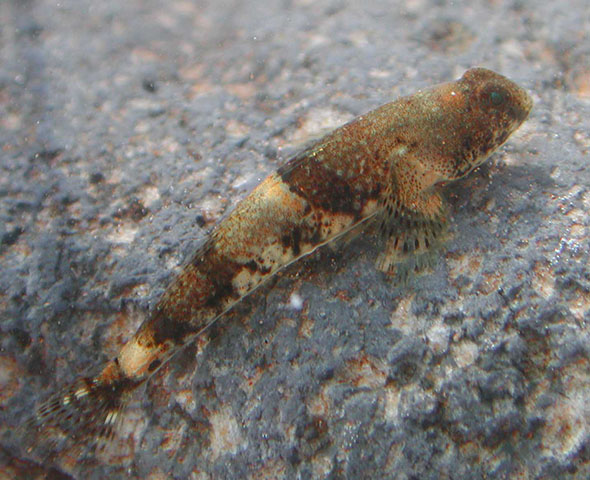| Gobiidae (Gobies), subfamily: Gobionellinae |
| 4.1 cm SL (male/unsexed) |
|
demersal; freshwater; pH range: 6.09999990463257 - 6.25; depth range 0 - 1 m |
| Oceania: Fiji. |
|
Dorsal spines (total): 7-7; Dorsal soft rays (total): 9-10; Anal spines: 1-1; Anal soft rays: 8-9. Distinguished from all other members of the genus by the following combination of characters: 8-9 anal rays; dorsal fins with VI - I,9-10 rays; first dorsal fin with a diagonal black band; females with a thin dark band crossing the chin; juvenile females with a triangular dark patch in region of isthmus; orange pigmentation on dorsal surface of body, and caudal and pectoral fin bases in both juveniles and adults; light blue or turquoise mottling on the head, nape and dorsal surface; sexually dimorphic head morphology (% HL), head lengths similar, males with 5% greater eye diameter and 30% greater lower jaw length, females with 5% greater snout length, 7% greater post orbital length and 6 % greater head width; sexually dimorphic fin morphology (% SL), males with 5% larger first dorsal fin base and females with 7% larger pectoral and 5 % larger pelvic fins (Ref. 55545). |
| Seems to prefer shallow and clear water riffles with slow or moderate current speed and with a substrate of small boulders and gravel (Ref. 55545). |
|
Least Concern (LC); Date assessed: 04 September 2011 Ref. (130435)
|
| harmless |
|
Known from six river systems on the south eastern sides of Viti Levu, Vanua Levu and Taveuni islands. It is quite rare in all river systems but it may be abundant since this is often overlooked due to its small size, coloration and cryptic habits. |
Source and more info: www.fishbase.org. For personal, classroom, and other internal use only. Not for publication.

